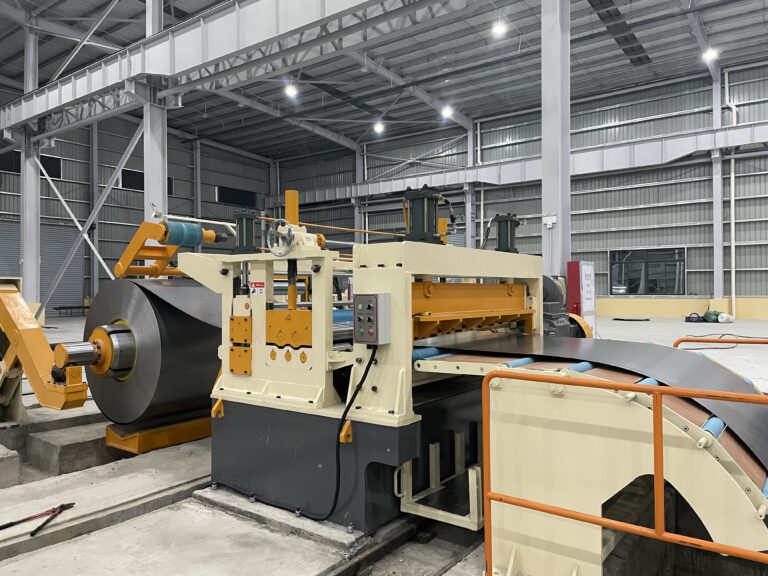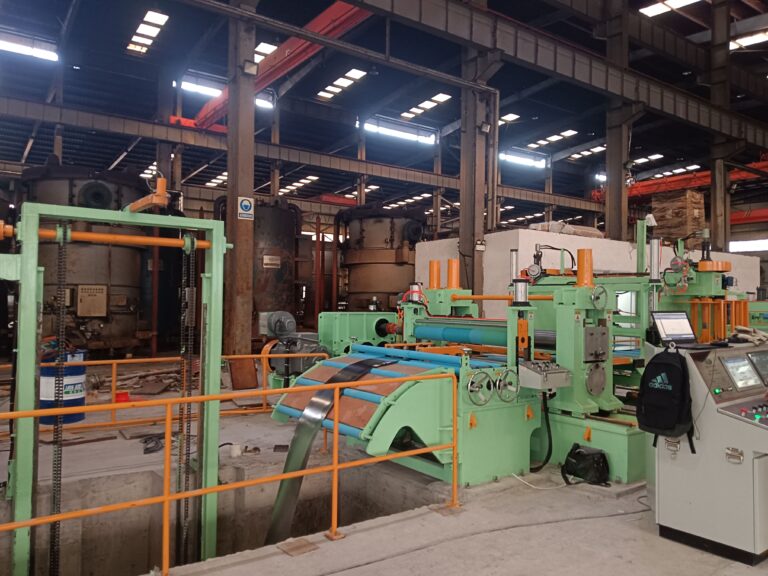Metal Slitting vs Cut-to-Length Lines: ROI-Focused Equipment Selection Guide 2025
Compare metal slitting and cut-to-length line ROI with expert analysis. Technical specifications, implementation guidance, and optimization strategies for production managers and metal processing engineers.
Production managers evaluating coil processing equipment face a critical decision that directly impacts operational efficiency, material utilization, and profitability. The choice between slitting lines and cut-to-length (CTL) lines fundamentally depends on your end product requirements and production volume characteristics.
Slitting lines excel when your operation requires multiple narrow strips from wide master coils. These systems transform wide coils into narrower strips while maintaining the coiled form, making them ideal for tube manufacturing, roll forming, and automotive component production. CTL lines optimize efficiency for flat sheet production with precise dimensional control, converting coils into flat sheets for fabrication, appliance manufacturing, and construction applications.
The financial impact is significant: processing diverse width requirements typically favors slitting lines for material yield optimization, while standardized sheet production often achieves better ROI through CTL systems. Understanding your specific processing profile, quality requirements, and operational constraints is essential for making the optimal equipment selection that maximizes both productivity and return on investment.
Understanding Your Core Processing Challenges
Production Volume and Product Mix Analysis
The first step in equipment selection involves analyzing your current and projected production requirements. Slitting lines deliver superior economics when processing multiple narrow strips represents more than 60% of your production volume. This advantage stems from the ability to process several strips simultaneously from a single wide coil, maximizing throughput and material utilization.
Key considerations for slitting line selection:
- Strip width requirements ranging from 10mm to 300mm
- Multiple strip production from single coil setup
- Coil-to-coil processing maintaining downstream efficiency
- Variable width flexibility for diverse customer specifications
CTL line optimization occurs when:
- Standard sheet dimensions dominate your product portfolio
- Flat sheet requirements exceed 75% of production volume
- Dimensional accuracy specifications demand precision leveling
- Integration with automated stacking systems provides operational advantages
Quality Control and Precision Requirements
Modern metal processing demands increasingly tight tolerances and consistent quality standards. Slitting operations achieve width tolerances of ±0.1mm to ±0.3mm depending on material thickness and equipment configuration. Critical quality factors include:
Slitting Line Quality Control:
- Edge quality and burr minimization through proper knife selection
- Strip width consistency across full coil length
- Coil telescoping prevention via tension control systems
- Surface finish preservation during processing
CTL Line Precision Capabilities:
- Length accuracy typically ±0.15mm for standard applications
- Flatness control through multi-roll leveling systems
- Surface protection during stacking and handling
- Dimensional consistency for fabrication processes
Material Handling and Setup Complexity
Equipment setup time directly impacts operational efficiency and production flexibility. Slitting lines typically require 30-90 minutes for changeovers depending on the number of strips and width adjustments needed. CTL lines often achieve faster changeovers (15-45 minutes) when processing similar material grades but require more complex adjustments when switching between significantly different sheet dimensions.
Setup optimization factors:
- Automated knife positioning systems reducing manual adjustments
- Pre-programmed job setups for repeat orders
- Quick-change tooling for common width configurations
- Material threading automation minimizing operator intervention
Comprehensive Technology Overview
Slitting Line Fundamental Mechanics
Slitting lines utilize rotary knife systems with precise clearance control to longitudinally cut wide coils into multiple narrow strips. The process maintains coil form while creating multiple products from a single wide master coil.
Primary system components:
- Hydraulic uncoiler with mandrel expansion for various coil inner diameters
- Servo-controlled slitting head providing precise knife positioning and clearance adjustment
- Multi-zone tension control ensuring consistent strip quality across all outputs
- Synchronized recoiling systems preventing telescoping and maintaining coil integrity
Material compatibility ranges:
- Thickness capacity: 0.3mm to 12mm for most applications
- Width processing: Up to 2,150mm depending on equipment specification
- Material types: Cold-rolled steel, stainless steel, aluminum alloys, and specialty metals
- Processing speeds: 1-250 meters per minute based on material and precision requirements
Cut-to-Length Line Architecture
CTL lines uncoil material, apply precision leveling to eliminate coil set, and produce flat sheets with controlled dimensional accuracy. The leveling process is critical for achieving flatness specifications required in fabrication applications.
Essential system elements:
- Heavy-duty uncoiler with servo-driven control for consistent material feeding
- Multi-roll leveling unit (typically 5-15 rolls) for coil set removal and flatness control
- Precision length measurement using encoder feedback systems
- Automated shearing mechanisms for clean, square cuts
- Stacking systems with adjustable pressure for surface protection
Performance specifications:
- Thickness range: 0.5mm to 20mm depending on leveling configuration
- Width capacity: Up to 2,000mm for most industrial applications
- Length accuracy: ±0.15mm standard, ±0.05mm with advanced measurement systems
- Processing speeds: 15-40 meters per minute based on material thickness and leveling requirements
Step-by-Step Implementation Framework
Phase 1: Requirements Assessment and Equipment Selection
Production profile analysis forms the foundation of optimal equipment selection. Document your current and projected processing requirements including:
- Material specifications: Steel grades, thickness ranges, and surface finish requirements
- Product dimensions: Strip widths or sheet sizes with tolerance specifications
- Volume projections: Monthly tonnage and peak production periods
- Quality standards: Industry specifications and customer requirements
Equipment evaluation criteria:
- Processing capacity matching peak demand periods
- Precision capabilities meeting quality specifications
- Automation levels appropriate for operational complexity
- Maintenance requirements and spare parts availability
Phase 2: Site Preparation and Infrastructure Planning
Facility requirements vary significantly between slitting and CTL installations. Proper foundation design is critical for equipment performance and longevity.
Infrastructure specifications:
- Foundation requirements: Minimum 4,000 PSI concrete with appropriate thickness for equipment weight
- Power supply: 480V three-phase with adequate capacity for drive systems
- Compressed air: 150 CFM minimum at 90 PSI with moisture filtration
- Material handling: Overhead crane capacity for coil handling (typically 20-40 tons)
- Safety systems: Emergency stops, lockout procedures, and operator protection
Phase 3: Installation and Commissioning Process
Sequential installation ensures proper equipment integration and operational performance. The commissioning process typically requires 2-4 weeks depending on system complexity and customization requirements.
Installation sequence:
- Foundation survey and alignment verification within specified tolerances
- Mechanical assembly with precision alignment of all major components
- Electrical installation including control systems and safety circuits
- Hydraulic and pneumatic systems testing and calibration
- Control system programming and operator interface configuration
- Performance testing and quality validation
Optimization Strategies and Performance Enhancement
Equipment Settings and Maintenance Protocols
Regular maintenance directly impacts equipment performance, product quality, and operational costs. Establishing comprehensive maintenance protocols prevents unexpected downtime and ensures consistent output quality.
Daily maintenance requirements:
- Visual inspection of knife condition and alignment
- Lubrication system verification and fluid level checks
- Tension system calibration and adjustment
- Safety system functional testing and documentation
Weekly procedures:
- Knife wear measurement and replacement scheduling
- Bearing condition assessment and lubrication
- Electrical connection inspection and tightening
- Performance data analysis and trending
Monthly overhauls:
- Complete knife inspection and reconditioning
- Hydraulic system pressure testing and fluid analysis
- Calibration verification for measurement systems
- Comprehensive safety system testing
Process Control and Quality Optimization
Automated process control significantly improves consistency and reduces operator dependency. Modern systems incorporate real-time monitoring and adjustment capabilities for optimal performance.
Process optimization elements:
- Automated knife positioning reducing setup time and improving accuracy
- Real-time quality monitoring with statistical process control
- Predictive maintenance systems using vibration and temperature monitoring
- Production data analytics for continuous improvement identification
Quality control implementation:
- In-line measurement systems for dimensional verification
- Surface inspection using vision systems for defect detection
- Statistical process control with automatic adjustment capabilities
- Traceability systems linking production parameters to final product quality
Troubleshooting Common Operational Issues
Edge quality problems represent the most common slitting line challenge. Proper knife selection and maintenance prevents 80% of edge quality issues.
Burr formation resolution:
- Root cause: Dull knives or excessive clearance (optimal range: 0.05-0.15mm)
- Solution: Implement condition monitoring every 400-500 tons processed
- Prevention: Material-specific knife selection with appropriate hardness matching
- Quality target: 2,000 tons/month): 12-18 month payback period
- Medium-volume facilities (500-2,000 tons/month): 18-30 month standard range
- Specialty processing applications: ROI driven by premium pricing for tight tolerances
Implementation Success Factors
Training and Skill Development
Comprehensive operator training ensures optimal equipment performance and safety compliance. Proper training reduces startup time by 40-60% and minimizes quality issues during the initial production period.
Training program components:
- Equipment operation procedures and safety protocols (40 hours)
- Quality control methods and inspection techniques (20 hours)
- Basic troubleshooting and maintenance procedures (20 hours)
- Advanced optimization and performance tuning (20 hours)
Performance Validation and Continuous Improvement
Establishing key performance indicators enables ongoing optimization and ROI validation. Regular performance reviews identify improvement opportunities and ensure equipment operates at optimal efficiency.
Essential performance metrics:
- Overall equipment effectiveness (OEE): Target >85% for automated systems
- First-pass quality rate: Target >98% for dimensional specifications
- Setup time per changeover: Benchmark and continuous improvement tracking
- Material yield percentage: Monthly trending and optimization initiatives
Conclusion and Equipment Selection Recommendations
The optimal choice between slitting lines and CTL lines depends on your specific production profile, quality requirements, and operational priorities. Based on comprehensive analysis of processing technologies and market requirements:
Choose slitting lines when:
- Multiple narrow strip production represents >65% of processing volume
- Width flexibility supports diverse customer requirements
- Material yield optimization directly impacts profitability
- Coil-to-coil processing maintains downstream operational efficiency
Choose CTL lines when:
- Standard sheet dimensions dominate your product portfolio
- Flatness specifications require precision leveling capabilities
- Integration with automated handling systems provides competitive advantages
- Just-in-time manufacturing demands rapid changeover capabilities
Consider hybrid solutions when:
- Production requirements include significant volumes of both strips and sheets
- Market diversification strategies require processing flexibility
- Operational complexity benefits justify increased equipment investment
The metal processing industry continues advancing toward greater automation, precision, and energy efficiency. Selecting optimal coil processing equipment today establishes competitive positioning for sustained profitability in evolving manufacturing markets.
For detailed equipment selection guidance specific to your processing requirements, technical consultation ensures optimal configuration matching your production goals and operational constraints. Professional assessment includes site evaluation, process optimization, and ongoing technical support to maximize equipment investment returns.




